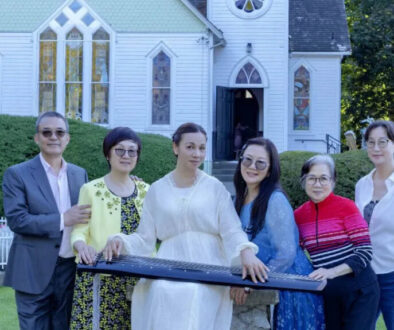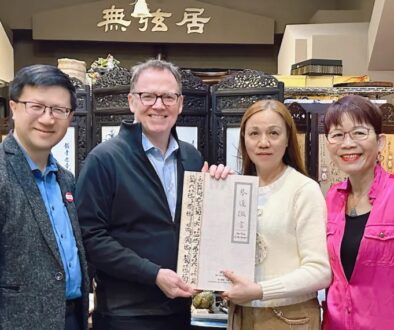Spreading Guqin Culture in Brazil
一盞心燈留巴西
琴音遍灑聖保羅
浩瀚文化留人間
Over the oceans to Latin America
Leaving my heartlight in Brazil
Showering São Paulo with guqin
The world with culture bountiful
A 20-plus hour flight over the skies of the United States and South America landed my beloved disciple Catherine Yan and me safely in São Paulo on August 21, 2019. The next day we had the good fortunes of gathering at the residence of an artist in the centre of the city, where classical Chinese literature was the subject of admiration.




Located in southeastern Brazil, São Paulo City is the capital of the province which bears the same name, and the biggest city in the country. It is also the most prosperous one in South America and a well known international mega-city. Thanks to the kind invitation and arrangements of two musical professors from the University of São Paulo, I had the honor of being the first person to give a lecture on guqin culture in English on campus.

The University of São Paulo (Universidade de São Paulo, USP for short) is one of the three public universities in the state of São Paulo. First founded on January 25, 1934, it is now Brazil’s biggest institution for higher education. The campus boasts its own publishing house, two hospitals, four museums, large stadiums and 46 libraries. According to its 2014 statistics published in its official website, the university has a student population of 92,064 and offers 249 courses. The university houses the top lecturers and researchers and its curriculum and areas of research are as wide as they are deep. Unsurprisingly, it is the most important research institution in the country.

University of São Paulo is made up of the facilities of philosophy, literature, science, São Paulo Polytechnic, agriculture, medicine, law, pharmacology and dentistry. The faculties of sports and the São Carlos Institute of Technology were subsequently added. Its campus moved to its present location of Armando de Salles Oliveira in the Butanta District of the city in 1960.

The university plays a crucial role in shaping Brazilian history, being the seedbed for the future leadership class of elites in many sectors of Brazilian society. Presidents João Goulart (1961 – 1964) and Fernando Henrique Cardoso (1995 – 2003) are both alumni.

This guqin lecture was a pleasant success, thanks to the arrangements of André Ribeiro, PhD in Music and Paulo de Tarso, professor of music at the university. The students who came to the lecture understood me when I went through the history of the guqin from the ancient kings to the Southern Song Dynasty. Besides getting immersed in the Chinese literary world, Catherine and I also played a few guqin pieces to guide them along the journey of history and music. In the course of the lecture, the students also asked about the notes systems from the past to the present as well as the positions of different keys.

On August 24th we held an exchange with the Guqin Association of Brazil. To my pleasant surprise, there are a couple of very learned Brazilians who are interested in guqin. One is a PhD in Music, a composer and a professor at São Paulo University. The other is a student in the faculty of medicine. The two founded the guqin association several years ago, and now it is made up of five members, with the addition of two Brazilians and one Chinese. It was exciting to discover a Chinese music group in São Paulo, directed by André Ribeiro: the Ensemble Gaoshan Liushui 高山流水. And how they have in their repertoire the song Dream of Red Chamber 《紅樓夢》, which we sang together at the time, in addition to playing the guqin pieces Running Water and Guangling Melody.
Despite our cultural and language differences, the guqin music seemed to have bridged the gap. The charm of this ancient Chinese musical instrument truly brought us friendship and mutual admiration.
The next day we had an interview by André Ribeiro at a local TV station. Conducted in English, we discussed the similarities between guqin playing techniques and calligraphy, and covered a broad set of topics including the relationships between the guqin and philosophy and literature.
With the conclusion of the exchanges, we finally had a chance to explore the country’s scenic beauty. We visited Iguazu Falls, the biggest falls in South America and the world’s widest. Located on the border between Brazil and Argentina, the horseshoe shaped falls span 4000 meters wide and have a vertical drop of 75 meters. An aboriginal name, Iguazu means magnificent waters. The falls line up both sides of the canyon and form a natural borderline delineating the two countries. Viewing the falls from the two different sides, surprisingly, yields different effects. It was a treat to witness the great falls and the ancient rain forest on the Argentinean side with local friends.
巴西首呈普庵咒
一曲彈罷眾生醒
七音宮商通天和
繼唱心經與梵唄
再奏關山及琴歌
功德非我歸佛祖
抱得天籟淨空樓
PuAn debut in Brazil goes
One song played to guests engaged
Seven cords of harmony to sway
Buddhist hymn and songs follow
Frontier Mountain and Flower Burial
Virtues thus created to Budda belongs
Celestial melodies the venue cradle
On August 31st we returned back to São Paulo after a few relaxing days to hold a performance at Liturgia da manhã em Brasil Templo Tzong Kwan. To cater to the majority of the audience, our concert kicked off with a Buddhist hymn 《心經》. To help them understand ancient Chinese literature, we performed guqin pieces Song of the Burial of Fallen Flowers 《葬花吟》 and Moon over the Frontier Mountain 《關山月》, and concluded with Pu-An Mantra 《普庵咒》from Southern Song Dynasty.
We deeply enjoyed and appreciated the guqin exchange experiences in Brazil, and look forward to a joint guqin concert with the locals next year.


















